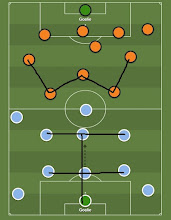The types of goalkeepers are
determined by a variety of factors that can have a significant impact on the
team's system.
Goalkeepers have always been
crucial position in the match. They are not only the last wall at the backline
but also play a bigger role in their team’s tactics. However, they are
frequently overlooked and often not on the same spotlight as the forwards or
attacking midfielders, unless they save penalties, especially in the shootout
or keep a clean sheet in a stalemate.
The men between the sticks, just
like players in other positions, has their own category. The type of goalkeepers
might have been noticed over time but it was the famous goalkeeping coach,
Frans Hoek, who defined it. He was a member of Louis Van Gaal’s coaching staffs
during his spells in Ajax, Barcelona, Netherlands national team and Manchester
United. The former Volendam man has extensive experience in goalkeeping, having trained a
number of world-class shot stoppers including Stanley Menzo, Edwin Van der Sar,
Victor Valdes, Pepe Reina, Sergio Romero and most recently, David De Gea.
In general, Hoek claimed that there were only two types of goalkeepers in the football. Most goalies fall
into one of these categories, though it is possible to be in both. In modern
football, such becomes more essential as it determines the tactics, the line up
or even the team’s level. Here are those two types:
The Reaction Goalkeeper
This kind of goalie is often
touted as the ‘classic’ or ‘traditional’ one. Hoek came up with the term ‘R-Type’
to describe their incredible reaction on the goal line. Historically, this type
has been dominant. The likes of Oliver Kahn, Petr Cech, Gianluigi Buffon are
the most obvious examples. Unfortunately, this kinds of shot stoppers are
getting less and less popular among the big teams since more of them prefer a
modern goalie with technical skills. They like to be more in possession of the
ball on the pitch and dictate the game.
On the contrary, the ‘R-type’ is
still widely used by mid or lower level teams as they are less dominant side in
the match and often forced to sit deep against the stronger teams. Here is the summary
of classic shot-stopper’s archetype.
|
Key attributes |
Good reflexes, quick decision-making, decisive commander in the
six-yard box, great athleticism and agility |
|
Weaknesses |
Lack of ball control and composure, inability to read the game |
|
Advantageous situation |
Direct shots and crosses, penalties, rumble in the penalty box, low-block
defense system |
|
Dangerous situation |
One-on-one duel, counter pressing from the opponents, high-line
defense system, back passes |
The Anticipating Goalkeeper
This is more advanced type of shot stopper and a variant of the so-called ‘ball-playing’ goalie. It is often known as the ‘modern’ or ‘eccentric’ one. Hoek coined the term ‘A-Type’ referring to their excellence in anticipation. This type of goalie is now in demand among big teams because they need to demonstrate their dominance in the game and on the competition by winning in style with attacking football. Playing defensive is not an option for most of them as they are expected to score more as well as concede the fewest goals, if not none at all.
The ‘A-type’ goalies are necessary for them as they can be utilized for the ‘sweeper-keeper’ role. Such needs more advanced skillset than traditional shot-stoppers as they will be involved in the build-up. In the past, the likes of Taffarel, Jose Luis Chilavert are the perfect example whereas Marc Ter-Stegen and Andre Onana are the ones to look out today. Here is the summary of the modern goalie’s archetype.
|
Key attributes |
Good passing and ball control, composure, excellent ability to read
the game, positioning |
|
Weaknesses |
Less agile, lack of good reflexes, prone to blunder |
|
Advantageous situation |
Attacking build-up from the backline, back passes, one-on-one duel,
high-line defense, scoring goals (when necessary) |
|
Dangerous situation |
Low-block defense, rumble in the penalty box, penalties |
Despite having these types,
certain figures can be in both of them. Manuel Neuer in his prime can be
considered both ‘R-type’ and ‘A-type’. He thrived in both spectrums back in
2010s until he suffered injuries after winning his second Champions League title in
2020. Another more recent example are
probably Manchester City’s Ederson and Liverpool’s Alisson Brecker.


Comments
Post a Comment